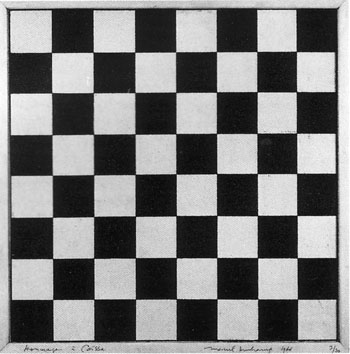
Homage to Caissa
 |
| Original version, 1966, 3/30 |
|
Original Version:
Jan. 1966, New York |
This piece illustrates how much chess was a part of Duchamp's life and work later on in his career. In fact, Duchamp is well known for his claims that he gave up artistic creation in 1923 in lieu of playing chess. His love of the game relates clearly to the idea of playing games in his artwork. Duchamp enjoyed the strategic and complex aspects of the game of chess, often integrating it into his artwork as a sort of metaphor.
As a late Readymade, Homage to Caissa is actually more pure than many of its contemporaries. It is essentially a standard chessboard. The only thing that keeps the board from being entirely functional is a lack of pieces. This exclusion proves telling; this is Duchamp's game. He doesn't let the viewer play the game completely; in the end, only Duchamp is in control.
In an interview late in 1992, Duchamp related, "I tried to protect my work with silence by dedicating myself for a long time to the game of chess. That is a game which always enthralled me because of its complexity. I always loved complexity" (Oliva 133). This statement not only acknowledges his love of chess, but also helps to illustrate the game's close relationship with the Readymades through a shared fondness of complexity. Duchamp once explained his affinity to chess as follows:
| "A chess game is something very plastic. You build it. It is a mechanical sculpture, with chess one creates beautiful problems and this beauty is made with the head and the hands" (Arman 87). |
A projected edition of thirty of these signed and numbered chessboards were to be "issued and sold for the benefit of the Marcel Duchamp Fund of the American Chess Foundation" in February 1966 (Schwarz 864). However, less than ten were actually issued.